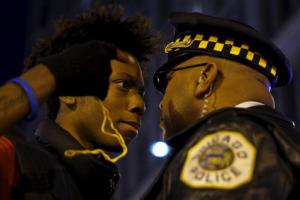Law enforcementU.S. police killed or injured more than 55,000 people during “legal interventions” in 2012
U.S. police killed or injured an estimated 55, 400 people during legal stop and search incidents and arrests in 2012, new research finds. Blacks, Native Americans, and Hispanics had higher stop/arrest rates per 10,000 of the population than Whites and Asians. And Blacks were by far the most likely to be stopped, and then arrested, the data show. “As the U.S. struggles to reduce citizen injuries during police contacts, it would seem prudent to train at-risk groups about appropriate behavior during police stops,” the researchers conclude.

Officer versus protestor // Source: theconversation.com
U.S. police killed or injured an estimated 55, 400 people during legal stop and search incidents and arrests in 2012, research published in the journal Injury Prevention reveals.
Blacks, Native Americans, and Hispanics had higher stop/arrest rates per 10,000 of the population than Whites and Asians. And Blacks were by far the most likely to be stopped, and then arrested, the data show.
And they are more likely than Whites to die at the hands of the police, although, when stopped or arrested, they are no more likely than Whites to be injured or killed during that incident.
“Police use of undue force is an enduring tinderbox issue in America,” say the researchers, and recent incidents in which police have shot unarmed citizens have provoked public outcry.
BMJ notes that in a bid to expand the data on the excessive use of force by U.S. police, the researchers counted and characterized injuries resulting from legal interventions — arrests, stop, and search incidents on the street, and traffic stops involving a search for 2012.
They used national data from the Vital Statistics Mortality Census; the 2012 Healthcare Cost and Utilization Project nationwide inpatient and emergency department samples; two newspaper censuses of deaths; FBI reports for 2012 and 2014 arrests; and the 2011 Police Public Contact Survey.
In 2012 arrests accounted for an estimated 12.3 million police interventions; street stop and search 2.8 million; and traffic stops involving searches 1 million. During these legal interventions, U.S. police fatally injured an estimated 1,000 people; and another 54,300 required hospital treatment for their injuries.
Firearms accounted for almost all the deaths (95 percent) and for around one in four (23 percent) of hospital admissions. Virtually all the remaining deaths involved tasers: an estimated sixty-five taser incidents resulted in admission to hospital and forty-eight more were fatal. Most of the non-fatal injuries stemmed from blows or blunt objects.
On average, an estimated 1 in 291 stops/arrests resulted in an injury requiring hospital treatment or the death of a suspect or bystander, equal to a ratio of 34 per 10,000 stops/arrests.
The life threatening nature of the injuries during police intervention was lower than for assaults. This suggests the police were not usually out of control when they physically confronted a suspect, say the researchers.
But gunshot wounds were significantly more likely to be lethal if they were sustained during police intervention rather than during an assault (40 percent vs 26 percent).
The numbers of those who were killed or injured as a result of legal police intervention per 10,000 stops/arrests did not vary by race/ethnicity. But death/injury was more common with increasing age, and was higher among men than women.
Young people were more likely to be arrested than older people.
Excess death rates among Blacks and youth at the hands of the police are reflections of excess, perhaps inappropriate, exposure, suggest the researchers.
“Consistent with our findings, simulation studies find police are no more likely to fire on unarmed Blacks than unarmed Whites, and high rates of black speeding citations per capita result from high violation rates,” they write.
“Given a national history of racism, the excess per capita death rate of Blacks from U.S. police action rightly concerns policy analysts, advocates, and the press. The excess appears to reflect exposure. Blacks are arrested more often than Whites, and youth more often than the elderly,” they continue.
“However, Blacks are not more likely than non-Hispanic Whites to be killed or injured during a stop/arrest, and youth have the lowest injury ratios. Ratios aside, even one person unnecessarily killed or injured by the police is one too many, and every racial/ethnic group has mourned losses from undue force,” they say.
“As the U.S. struggles to reduce citizen injuries during police contacts, it would seem prudent to train at-risk groups about appropriate behavior during police stops,” they conclude.
— Read more in Ted R Miller et al., “Perils of police action: a cautionary tale from U.S. data sets,” Injury Prevention (25 July 2016) (DOI: 10.1136/injuryprev-2016-042023)